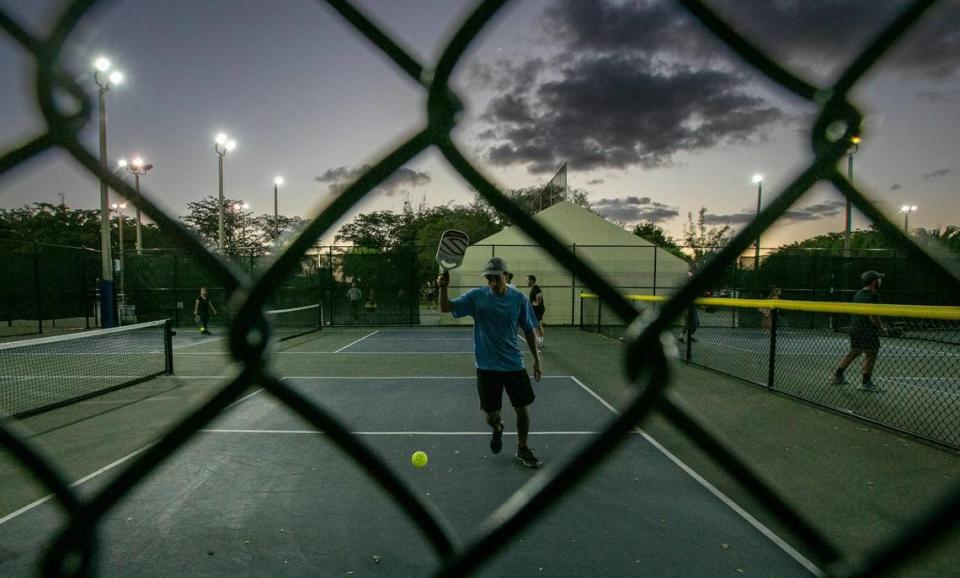Are you sneezing your head off? Why Miami and other Florida cities are suffering
Do you have the sniffles? Watery eyes?
It might be a cold, but it could also be allergies. And South Florida this year has seen more pollen than this time last year, according to Naresh Kumar, a professor of environmental health at the University of Miami Miller School of Medicine.
Its been “pretty intense,” said Kumar, who has monitored pollen in the region since 2017 and is the director of UM’s Climate and Health graduate program. The researcher said South Florida has seen more pollen this year because of a “prolonged blooming season” for trees and plants due to a “milder winter” and “extra rain” in the beginning of spring.
Allergies are common in the spring, though people can suffer from sniffles and itchy, watery-eyes year-round in the Sunshine State. Scientists are also noticing longer allergy seasons in the country as warmer temperatures caused by climate change lead to more pollen in the air for longer periods of time. And more sneezing and congested noses.
Worsening allergies are “a really clear example of how climate change is impacting us now, every spring, in every breath that we take,” William Anderegg, an associate professor at the University of Utah who studies the impact of climate change on pollen seasons in North America, told Yale Climate Connections last year. “This is climate change in our own backyards, in our own towns and cities. It’s not future generations or other countries or future decades.”
Two Florida cities, Sarasota and Orlando, are considered to be one of the Top 20 “allergy capitals” in the nation, according to the recently published 2024 report by the Asthma and Allergy Foundation of America. The top 20 list is based on pollen scores for trees, grass, weed pollen, over-the-counter allergy medication use, and number of allergy specialists in the 100 most-populated U.S. cities.
Sarasota and Orlando, both in Central Florida, were ranked No. 13 and No. 16, respectively, in the report. Miami ranked No. 48 on the list. That’s a plunge from last year’s report, when Miami ranked No. 14 and joined Orlando and Sarasota in the Top 20 list.
Miami’s lower ranking this year doesn’t mean circulating allergies aren’t causing you to ACHOO.
While Miami did see a slight improvement in its grass pollen score, moving from “worse than average” to “average,” its overall allergy situation has not improved, according to the foundation. The main reason why Miami’s ranking decreased this year is because 15 cities saw their score worsen, causing them to jump more than 16 spots in the rankings, and ahead of Miami, said Hannah Jaffee, the foundation’s research manager.
So, what’s the allergy situation currently like in South Florida?
Miami-Dade and Broward have a moderate risk for allergies Tuesday based on current weather conditions, according to the Weather Channel.
Forecasters expect Broward’s allergy risk will be moderate this week, though Miami-Dade’s risk will increase Wednesday, before dipping back to moderate during the weekend.
What causes allergies in South Florida?
Kumar says some of the most common causes of allergies in South Florida include:
▪ Tree pollen, especially from oak and pine trees, which are common in the region.
▪ Ragweed pollen. The plant grows throughout the U.S., including in Florida. It’s a common cause of hay fever and can also trigger asthma attacks. While each plant only lives for one season, one plant can produce up to 1 billion pollen grains, which can be carried far by the wind, according to the U.S. Environmental Protection Agency.
▪ Mold. South Florida’s humid climate makes it easy for mold to grow outdoors and inside. Mold can cause stuffy nose, sore throat, coughing and skin rashes. People with asthma or who are immunocompromised can sometimes have more severe reactions.
Kumar’s previous research has shown that how much pollen, and what type of pollen is in the air, varies by location. He’s now in the process of creating a new pollen collection project that will help provide more real-time data. As part of the project, Miami-Dade volunteers would be able to swab their windshields for pollen and send it into a lab for testing. Researchers would then be able to analyze the collected pollen to gather a variety of data, including what type of pollen is in an area.

What is the risk for allergies in Miami-Dade, Broward and the Keys?
The Asthma and Allergy Foundation of America recommends people monitor pollen forecasts and check local air quality data to get an idea of what your risk for allergies and asthma will be.
The Weather Channel, for example, has a 15-day allergy forecast that ranks a ZIP code’s allergy risk from very low to very high. It also offers a 3-day pollen breakdown for tree pollen, grass pollen and ragweed pollen. For air quality data, a good option is AirNow, which tracks air quality data across the country.
The risk for allergies associated with tree, grass and ragweed pollen varies by where you are.
Miami, Miami Beach, Key Largo and Key West, for example, have a low risk of grass pollen through Thursday, the forecast shows. Doral, Hialeah, Kendall, Coral Gables, Homestead, Miami Gardens, Fort Lauderdale, Hollywood and Davie, on the other hand, have a moderate risk for grass pollen through Thursday. There is no risk for tree or ragweed pollen through Thursday in these cities, according to the forecast.

What can you do to reduce allergies?
Besides taking allergy medications as needed, there are preventative measures people can do reduce allergies. Some suggestions:
▪ Monitor pollen forecasts and check local air quality to get an idea of what the allergy risk will be in your area. “On days with high pollen counts or poor air quality,” limit how much time you spend outdoors or wear a mask and cover your hair, the foundation said. If you’re going to be outside, Kumar said you can also consider wearing protective goggles or glasses to prevent pollen from getting into your eyes.
▪ Shower after being outdoors and change your clothes to remove any pollen you might have picked up outside, according to the Weather Channel. And keep windows and doors closed to avoid pollen being blown into your home.
▪ Use a saline rinse to help wash out pollen irritating your nose.
▪ Kumar also recommends people visit the beach, particularly in the afternoon, if they want to get some fresh air without worrying about allergies. Ocean air is good for your lungs, he said.
However, make sure to stay away from the beach if it has lot of smelly seaweed. The smell of sargassum can sometimes cause health problems for people with chronic respiratory conditions.

